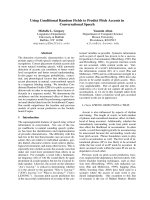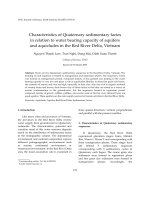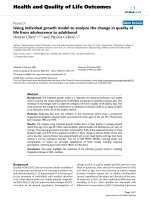Using temporal MODIS data to detect paddy rice in Red River Delta
Bạn đang xem bản rút gọn của tài liệu. Xem và tải ngay bản đầy đủ của tài liệu tại đây (305.35 KB, 6 trang )
VNU Journal of Science, Earth Sciences 28 (2012) 100-105
Using temporal MODIS data to detect paddy rice in
Red River Delta
Doan Ha Phong*
Vietnam Institute of Meteorology, Hydrology and Environment,
23/62 Nguyen Chi Thanh, Hanoi, Vietnam
Received 12 March 2012; received in revised form 26 March 2012
Abstract. Information on the area and spatial distribution of paddy rice fields is needed for food
security, management of water resources, and estimation of Methan emission as well. MODIS
remote sensing data including visible bands, near infrared band and short wave infrared band is
foundation of calculating vegetation indices such as NDVI, EVI and LSWI. These remote sensing
indices are very sensitive and strongly correlative to physiological status of plant, they are useful
means for detecting and mapping paddy rice. This paper focus on an algorithm that uses time
series of these vegetation indices to identify paddy rice areas based on sensivity of LSWI to the
increased surface moisture during the period of flooding and rice transplanting.
Keywords: Remote Sensing, Paddy rice, NDVI, LSWI, Red River Delta.
1. Introduction∗
In addition, the effective and timely paddy field
mapping play an extremely important role in
environmental sustainability, particularly in the
management of water resources and
management of greenhouse gas emissions,
particularly in the context of global climate
change have been happening complicated,
threatening to the sustainable development of
mankind. According to FAO statistics
(FAOSTAT, 2001) [1], the Asian countries use
more than 80% water resource for irrigation,
even more than 95% in some countries. Paddy
rice is also an vital source of methane
emissions, according to some studies (Prather
and Ehhalt, 2001) [2] rice cultivation
contributed 10% of total methane emissions
into the atmosphere, which greatly affect the
chemical composition of the atmosphere and
climate.
Rice monitoring in general and detecting
identifying paddy areas in particular always
have important implications for national food
security, and since then this issue is closely
related to other socio-economic problems,
especially when Vietnam is the second biggest
rice exporter in the world. At present, the
anomaly weather phenomena such as droughts,
floods, heatwaves, cold spells damage to crops
are increasing with growing levels of damage;
as a result, the risk of bad havests are also going
up crop if appropiate assessments and
monitoring to remedy, mitigate damage caused
by them are not announced in a timely manner.
_______
∗
Tel: 84-4-38358626.
E-mail:
100
101
D.H. Phong / VNU Journal of Science, Earth Sciences 28 (2012) 100-105
Recently, many scientists have developed
new approaches in using remote sensing to
research crops in general and to research rice in
particular based on the generation of new
optical sensors such as VGT (Xiao et al, 2002)
[3] and MODIS (Xiao et al, 2006) [4]. Optical
remote sensing data owns its drawback which is
dependent on atmospheric conditions and
cloud, but the very high time resolution, data
can be collected daily, hence that matter of fact
can monitor the phenology details of each stage
of the growth of rice. Based on the scientific
basis which is the characteristic of absorption
and emission of spectrum of plants in different
bands, vegetation indices and surface water
index are designed to reflect objectively about
physiological performance of plants.
In this study, the authors used an algorithm
based on 8-day composite MODIS data. On the
foundation of the variations of rice field
surface’s characteristic over the growth periods,
the algorithm will detect the paddy field areas
in 2009 in Red River Delta region.
2. The study area
The Red River Delta occupies the area of
17.321 km2 in northern Vietnam, extending
from 21000’N to 21020’N and from 105050’E to
106050’E. Climate’s characteristics is tropical
and subtropical monsoon, the average temperature
in this region is about 22.5 to 23.50C, annual
average rainfall is 1400-2000 mm.
With this feature, the process of rice
production in the Red River Delta has many
advantages, but there are also many extreme
weather phenomena causing adverse impacts on
rice cultivation. The temporal structure of the
rice crop Red River Delta is divided into two
crop, the summer-autumn season and the
winter-spring season (Figure 1). In 2007, the
total planted area of 10 Red River Delta
provinces during the two crop seasons was
approximately 553,200 and 558,500 ha
(General Statistics Office, 2009), respectively,
total production reached 3.2 and yield 3.1
million tons and 5.7 and 5.5 tonnes/ha,
respectively.
3. Database and methodology
3.1. Database
MODIS sensor has 36 spectral bands, the
first 7 bands which is designed for research
land cover and land surface. Each combination
MODIS 8 days (MOD09A1) include surface
reflectance of the above seven spectral bands at
500 m spatial resolution, in which the
atmosphere calibration such as elimination of
aerosol, thin clouds have been performed.
During the process of detecting rice field areas,
the authors have used a number of spectral
bands (Table 1) in the 8-day composite data of
Terra MODIS MOD09A1 during the entire
duration of 2009, including 46 images, the
extent of the study area is located entirely in
one patch named h27v06, containing the entire
Red River Delta.
Table 1. The selected MODIS bands
Figure 1. Structure of rice crops in the Red River Delta.
Bands
Wavelength Ranges Spatial Resolution
1 (Red)
0.620-0.670
500 m
2 (NIR)
0.841-0.876
500 m
3 (Blue) 0.459-0.479
500 m
6 (SWIR) 1.628-1.652
500 m
102
D.H. Phong / VNU Journal of Science, Earth Sciences 28 (2012) 100-105
3.2. Research Methodology
A unique physical feature of paddy rice
fields to identify and distinguish between rice
field and any other types of land cover is that
rice plants are grown on flooded soils in a short
time. The temporal aspect of rice field’s surface
development is classified into 3 main periods:
the sowing–transplanting period, the growing
period, and the after-harvest period (Le Toan et
al, 1997) [5]. During the sowing-transplanting
period, soil surface is a mixture of water and
plants with water depth of 2 cm to 15 cm.
About 50 to 60 days after sowing-transplanting
period, rice foliage covers almost the entire land
surface area. The end of this period to the
beginning of harvesting, moisture storage of
stem, foliage, and the amount of leaf decrease
dramatically.
Figure 2. The temporal change of vegetation indices in paddy field.
Based on the characteristics mentioned
above, to determine the change of the mixture
of surface water and rice in the field over
periods, the spectral bands or vegetation indices
sensitive to both water and vegetation are
needed. The vegetation indices were calculated
from the analysis process using spectral bands
such as near infrared, mid-infrared bands is that
the intermediate parameters which reflect the
distinct characteristics and dynamics of
development characterized by paddy land in the
growing period. Figure 2 demonstrates the
dynamics of growth and development over time
of a pixel corresponding to a field rice field
samples. Two distinct peaks of EVI and NDVI
index for the period shown in the second rice
crop to be a viable crop and crop, which is the
stage where the vegetation index reached
maximum values, the opposite poles NDVI and
EVI's and primary,there is also the only time in
two years of paddy land which LSWI higher
value NDVI and EVI values, is the new rice
transplanting period, the surface is covered by
farmland water.
To detect paddy rice field areas by 8-day
composite MODIS data, the authors used a
detection algorithm paddy land through analysis
dynamics of the time LSWI index, NDVI and
EVI [4]. Index normalized difference vegetation
index NDVI is a plant very common use in
monitoring the plant status changes, reflecting
the level of green plants. Vegetation index EVI
enhanced sensitivity higher NDVI index in
areas with high biomass (Huete et al, 2002) [6].
EVI is often used to evaluate the development
of plants with large amplitude fluctuations, such
as rice growing areas, in addition, EVI closer to
D.H. Phong / VNU Journal of Science, Earth Sciences 28 (2012) 100-105
reality than on the NDVI in vegetation
monitoring when high humidity. Remaining
surface water LSWI index denotes the level of
water content changes of surface coatings, one
of the indicators to assess the drought of
vegetation cover in general and in particular
crops. The indicators above are as follows:
ρ − ρ red
(1)
NDVI = nir
ρ nir + ρ red
EVI = 2.5 ×
LSWI =
ρ nir − ρ red
ρ nir + 6 × ρ red − 7.5 × ρ blue + 1
ρ nir − ρ swir
ρ nir + ρ swir
103
(2)
(3)
Where: ρNIR, ρred, ρblue, ρswir turn is the reflection
coefficient of the near-infrared channel, red
channel, the channel positive and mid-infrared
channels.
Notes: mark { is equivalent function” and”; mark [ is equivalent function “or” EVI * is EVI in day after the date of
sowing, transplanting 40 days (5 composite images) EVImax is max value of EVI in the current crop.
Figure 3. The flowchart of detecting paddy field ares algorithm.
104
D.H. Phong / VNU Journal of Science, Earth Sciences 28 (2012) 100-105
Detecting algorithm focus areas for rice
cultivation period through flooded paddy field
in time of sowing and rapid growth of rice in
the dawn of the next season when fully mature
leaves. When surface water LSWI index
reached higher values of vegetation indices
NDVI and EVI, which is the hallmark of rice
land under water at sowing transplant period.
Based on the results of previous studies and
field studies, pixel threshold wetlands in this
study is LSWI + 0.05 ≥ EVI or LSWI
+ 0.05 ≥ NDVI. After classification of
wetlands, the next step of the study was to
determine whether it is the will or just sowing
in flooded areas or waters as often as ponds,
lakes, rivers and streams. The author used the
assumption that the index value of 5 photos
combined EVI 8 days after sowing transplant
period (40 days) to reach half the maximum
value of the EVI index is paddy land. This
assumption is established from distinct
physiological characteristics of rice plants after
sowing transplant period, rice growing and leaf
area index reached a maximum within 2
months. The steps of the algorithm are specified
in figure 3 above.
4. Results and discussion
Map of the area of rice from data analyzed
MODIS
When performing the detailed steps in the
research process has developed, need careful
consideration and evaluation of various factors
that influence the external environment (Figure
3). First, always causing factors influence the
optical remote sensing data is cloudy, it should
be removed first. Waters frequently and
evergreen forest areas are also confusing
objects with the land and planted rice grown on
rice, two factors are detected and eliminated by
the multi-period conditions. Finally, the ricegrowing areas are considered to match the
digital elevation model DEM to remove the rice
area is analyzed on the height and slope
irrelevant, unrealistic. The end result is to map
the rice crop in 2009 is shown in Figure 4.
D.H. Phong / VNU Journal of Science, Earth Sciences 28 (2012) 100-105
105
Figure 4. Map of paddy field ares in the Red River Delta derived from MODIS data.
Compared to statistical data, the area of rice
cultivation area of the Red River Delta with the
sequence analysis of MODIS data in 2009 an
area of 572.9 thousand ha, according to
statistics in 2008 reached 558.6 thousand ha.
Thus, the error compared to the statistics of the
total rice area of the Red River Delta is only at
2.6%. For provinces in the study area, but also a
few provinces have considerable value as
disparities in Nam Dinh, Ha Noi, Hai Duong
(comparison table in Figure 4), rice area from
image analysis is generally quite accordance
with provincial statistics, a symbol in the chart
showing the correlation of the two sources of
data of 10 provinces, squared correlation
coefficient reaches a high value R2 = 0.8911.
5. Conclusion
Research has confirmed the ability of
MODIS data and multi-period detection
algorithm rice planting areas in the
establishment of distribution maps of paddy
land. With the advantage of resolution and time
updates, MODIS data suitable for the overall
assessment of regional rice area.
Detection algorithm based on the rice
physical changes of paddy land, and focus on
the detection time of sowing through a
temporary increase of the spectral index is
sensitive to water (LSWI). This algorithm is a
very objective and can be extended another year
to apply for, or applied research for other crops.
Although there are many sources of error
affecting the usual optical remote sensing of
clouds as noise, effects of topography,
resolution limited space but generally results
from analysis of rice maps are similar MODIS
with statistics, in accordance with the terms of
the actual spatial distribution and area
measurements.
References
[1]
[2]
[3]
[4]
[5]
[6]
FAOSTAT, Statistical Database of the Food
and Agricultural Organization of the United
Nations, 2001.
Prather & Ehhalt, Atmospheric chemistry and
greenhouse gases. Climate change 2001: The
scientific basis, Cambridge University Press
(2001), UK. Pp 239–287.
Xiangming Xiao, et al, Observation of flooding
and rice transplanting of paddy rice fields at the
site to landscape scales in China using
VEGETATION sensor data. International
Journal of Remote Sensing (2002), 23, ElsevierUSA, pp 3009– 3022.
Xiangming Xiao, Stephen Boles, et al, Mapping
paddy rice agriculture in South and Southeast
Asia using multi-temporal MODIS images.
Remote Sensing of Environment (2006), 100,
Elsevier-USA, pp 95 – 113.
Le Toan, T., Ribbes, F., et al, Rice crop
mapping and monitoring using ERS-1 data
based on experiment and modeling results.
IEEE Transactions on Geoscience and Remote
Sensing (1997), 1, IEEE-USA, pp 41–56.
Huete, A., et al, Overview of the radiometric
and biophysical performance of the MODIS
vegetation indices. Remote Sensing of
Environment (2002), 83, Elsevier-USA, pp
195– 213.









